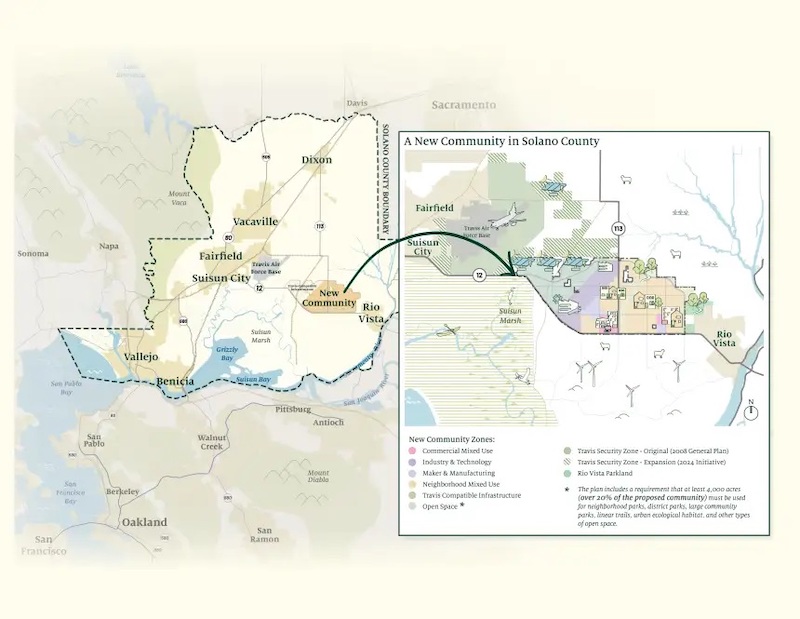For all of California Forever's flaws, it is a litmus test: are California’s public officials and housing advocates really serious about trying to meet the Bay Area’s housing needs, or is housing for them just another series of performative gestures?

Nobody loves tech billionaires, for lots of good reasons. But every once in a long while, some of them just might stumble on an idea that could benefit a lot of people in important ways. And when that happens, we should not only acknowledge it, but try to help make it a success.
I’m talking about the proposal to build a new city in Solano County, California, which has been given the unfortunate name of California Forever by some tone-deaf PR flack. From the point when the plans surfaced in mid-2023, reactions have been far more negative than positive, with writers voicing outrage over land purchase practices, the spoilation of rural Solano County, the lack of public transit, and the impact on Travis Air Force Base. While a few writers have grudgingly acknowledged that the new city might help meet California’s housing needs, praise has been faint at best.

As a long-time urbanist and housing advocate, I’d like to take a different tack. I think this could be one of the best developments in housing and urban growth to happen in the Bay Area in a long time. I say, could be, because there are some serious ‘ifs.’ But the way to address those questions is neither to give California Forever a blank check, nor to shoot them down. Instead, the state of California, along with others who care about the region’s future, should engage with the would-be city builders – and embrace them, but at a price. Because this project is the first thing anybody has proposed that could give the Bay Area a shot at making up at least some of its vast housing deficit in our lifetimes.
But first, let’s put the conspiracy theories to rest. Let’s face it, if you want to build a new city, or anything like that, you need a lot of land. And there are only two ways for a developer to get enough land. Either own it to begin with, like Irvine Ranch in Orange County, or assemble it piece by piece. But if you’re not lucky enough to own 50,000 acres already, the only way to get there is by stealth, so the speculators don’t move in and kill your project before you’ve even started. That’s what James Rouse did 60 years ago when he assembled the land for Columbia, Maryland, which today is recognized as one of the best places to live in America, as well as one of the most racially integrated. So, let’s get over that.
The big issue, though, is getting enough housing built. Nobody seriously disputes that. According to the state of California, the Bay Area needs 441,000 more homes by 2031. That is widely seen as lowballing the real need. An analysis by UCLA experts concluded that a more reasonable number would be close to 700,000, while YIMBY Action has called for 943,000. Whatever the exact number, it’s a big one.
To reach even the state’s modest numbers, the Bay Area needs to vastly ramp up housing production. Based on the last five years’ building permits, Alameda County would have to double annual production, while Marin would have to go from 225 to 1800 per year and San Francisco from 3,000 to over 10,000. If anybody believes that numbers like that are going to be achieved by zoning reform and transit-oriented development, a few houses here and a few multifamily developments there, they probably also believe in the tooth fairy.
Certainly, there’s room for some growth without building new cities. Upzoning will encourage some higher density redevelopment and unlock the potential in some underutilized parcels here and there. The experience to date shows that ADUs will create a respectable number of new homes in people's back yards. But those who pitch the mantra of “it’s the zoning, stupid” have no idea how difficult the development process is, and how hard it is to get a development to pencil out, as they say, in the Bay Area.
That’s where California Forever comes in. If they can provide 160,000 or so homes, a number that can comfortably fit in the amount of land they control, that will make a serious dent in meeting the Bay Area’s housing needs, and filling the gap between what is needed and what the region could otherwise make happen. It will go much further toward meeting those needs than anything else currently on the table.
For all the proposal’s manifest flaws, it is ultimately a litmus test: are California’s public officials and housing advocates really serious about trying to meet the Bay Area’s housing needs, even at the risk of antagonizing quite a few people, or is housing for them just another series of performative gestures?
That doesn’t mean California Forever doesn’t have some serious flaws, two in particular. First, it makes no commitment to including affordable housing. The plan talks about affordable densities and workforce housing, but makes no commitment to provide any housing at price levels the region’s low and moderate income families could afford to pay – although the developers do offer to fund what is likely to turn out to be at most a few hundred low-income units elsewhere in the county. Second, the plan does not provide for an efficient transit connection to the rest of the Bay Area.
Both need to be addressed, but the only way they can happen is if the state makes solving both problems a condition of embracing the project, and then works with the developers to make both a reality. Without significant state involvement, there’s no way California Forever can provide a workable transit connection to the rest of the region, and everybody knows that.
In the end, one of three things will happen. The state could embrace the project, and make sure it happens in a way that best meets California’s housing needs and sustainability goals. Or somehow the developers will prevail despite the opposition and California Forever will get built, but fall far short of what it could have been. Or it will die, and the state will blow the best opportunity it’ll ever get to build the housing it desperately needs.

Planetizen Federal Action Tracker
A weekly monitor of how Trump’s orders and actions are impacting planners and planning in America.

Chicago’s Ghost Rails
Just beneath the surface of the modern city lie the remnants of its expansive early 20th-century streetcar system.

Amtrak Cutting Jobs, Funding to High-Speed Rail
The agency plans to cut 10 percent of its workforce and has confirmed it will not fund new high-speed rail projects.

Ohio Forces Data Centers to Prepay for Power
Utilities are calling on states to hold data center operators responsible for new energy demands to prevent leaving consumers on the hook for their bills.

MARTA CEO Steps Down Amid Citizenship Concerns
MARTA’s board announced Thursday that its chief, who is from Canada, is resigning due to questions about his immigration status.

Silicon Valley ‘Bike Superhighway’ Awarded $14M State Grant
A Caltrans grant brings the 10-mile Central Bikeway project connecting Santa Clara and East San Jose closer to fruition.
Urban Design for Planners 1: Software Tools
This six-course series explores essential urban design concepts using open source software and equips planners with the tools they need to participate fully in the urban design process.
Planning for Universal Design
Learn the tools for implementing Universal Design in planning regulations.
Caltrans
City of Fort Worth
Mpact (founded as Rail~Volution)
City of Camden Redevelopment Agency
City of Astoria
City of Portland
City of Laramie






























